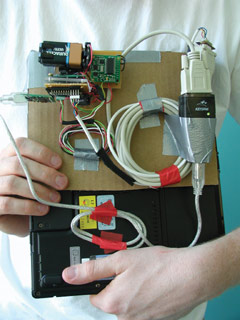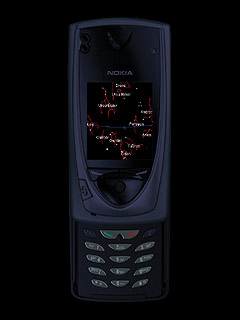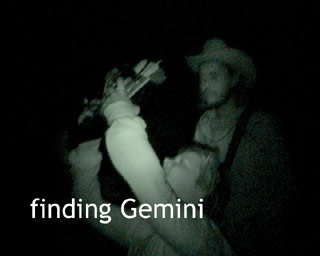-
In this experience prototype, a Tablet PC was augmented with sensors: an accelerometer and two compass chips, letting the device detect its tilt and cardinal direction. This information was used to control a custom-written constellation browser module, which matched the tilt of the Tablet PC against a star map, enabling direct comparison with the night sky. The constellation display was framed on screen by a cell phone image, to reinforce the idea that this would be used on such a device, and to test at the actual resolution of a cell phone display. By pressing one of the number keys on the interface, users could view the constellation lines and names, which would fade over the course of a few seconds. A different button would display the same information without fading.
Four volunteer students were given this device and asked to use it one night to find their star sign constellation in the sky. They were asked to try it once with key control of the display and once using the sensors. Afterwards they were given questionnaires about their experience.
|
|
||||
|
Streaming Video
View a 3 MB Quicktime streaming video.View a 7 MB Quicktime streaming video.
Experience Prototype Results
-
The students spent 30 minutes in total with the device, switching between users, who acted as guides, and others, who spent time watching the sky. Each found their constellation using the sensors first. Three were able to find it in the sky afterwards. The fourth student's constellation had not risen yet, but the student was pleased to know where it would rise. All enjoyed looking at the foreign constellations visible "under the ground" using the device.
When the sensors were disabled and the students asked to use key control to move the display, they reported that the experience was as enjoyable, but entirely different. Manually, the task was to apply knowledge learned with the sensors. One of the users asked to switch back and forth between the manual and automatic mapping modes to test his guesses.
The students spent time connecting their constellation with other nearby or well-known constellations, to aid in their memory. For this they left the constellations visible rather than use the fading display. None reported preferring the fading mode.
Some usability problems were uncovered in the questionnaire. The students' eyes had difficulty adjusting between the backlit LCD screen (even with a black background and dimmed graphics) and the night sky. The size and the weight of the Tablet PC became uncomfortable during the demo, making them want to cradle the device and not hold it up to the sky. These issues would not be identical in the ideal implementation. In the questionnaire, the students were able to imagine some surprising applications for such a device for their own learning interests including 3D time-scrolling displays of historical sites while on vacations, distant-object labeling for panoramic views, and exploring famous artworks. All noted that they would probably not use the device in their daily lives on a regular basis, and so would be most interested in renting them while on vacation or visiting art galleries, rather than including the cost of such a device in their service.
| NEXT> Genius Loci |


